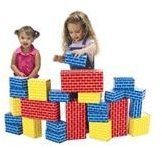Three Block Projects for Preschool Children: Imaginative Learning!
Letter Blocks
Out of the many block projects for preschool children that you can adopt in your own class, creating letter blocks is one of the most useful and vital. It can promote remarkable improvement not only in letter recognition, but also in reading and spelling words, language skills development, and verbal communication.
Simply prepare old wooden blocks or cardboard boxes of the same size for the kids. Have them paint these with a color of their choice, then stick different letter cut-outs on the six faces of each block or box with the use of glue. You may also mix the glue with the paint prior to the activity, so it will be easier for the children to just attach the cutouts on the surfaces. Instead of just letter cutouts, you may also opt to add pictures representing words that begin with the letters (e.g. apple for A, boat for B, car for C).
One variation for this simple block project is to let the older children write the letters themselves while you guide them. Display a poster that shows all the letters in the alphabet and have them choose the ones they would like to have on their blocks or boxes. You can also create dotted lines of the letters beforehand, which younger kids can trace. In this way, they are also able to practice writing the letters.
When the letter blocks have been prepared, store them in a separate container along with the other toys on the classroom shelves so kids have easy access to them. It will develop a sense of pride and ownership as well, which will help encourage them to play with these more. It will also increase interest.
Do not forget to incorporate these blocks in your lessons and activities, as you can have the children trace letters with their fingers or create words.
Shape Blocks
Recognizing and identifying shapes are basic skills taught in preschool. This is why it would be a relevant project for your
preschoolers to make their very own shape blocks! The mere process of creating or designing these blocks themselves will certainly help them remember the shapes much, much better.
It is easy! Just prepare the same basic materials used for making the letter blocks above— cardboard boxes or wooden blocks, paint with glue, paintbrushes, and aprons. Then instead of letter cutouts, use shape cutouts in various colors. You may want to be more creative by also having pictures that depict the shapes (e.g. clock for circle, pyramid for triangle, heart-shaped pillow for heart). And applying the same variation as the letter blocks, you may have the children trace or draw the shapes themselves instead of sticking the cutouts on the faces of each block or box.
Shape blocks can be utilized in class activities and other lessons that are not just about shape recognition and identification. For instance, you can boost the children’s ability to classify by having them line up the blocks on the floor or on a table, with the same shape facing one direction to show that they have grouped those that are the same.
You can also teach patterns by lining up some shapes (e.g. square, square, circle, square, square) and then asking a child to get a block to finish the pattern. Furthermore, you can play games with these shape blocks! One example is to give a description such as “red triangle with a blue background” or “picture of rectangular pillow,” and let the child hand the correct block to you.
Picture Blocks
There are a great variety of block projects suitable for your preschoolers, and another one that you can put to good use in your class is picture blocks. Remember that young kids are naturally visual learners, so pictures are very important in teaching them concepts and skills that are primary in their basic learning.
Have each preschooler create a set of picture blocks, perhaps a minimum of three pieces. Once again, you may use wooden blocks or cardboard boxes that the kids can paint themselves. Once the paint has dried, help them tape square plastic pockets on every surface of each block or box. This is more practical as you can keep changing the pictures that you place on the faces of the blocks/boxes, depending on your lesson or theme.
You can place pictures that represent events in a story you told in class, so the children can arrange the events in order or use the blocks to retell the story in their own words. You can also use pictures that show steps in a process, which will further improve the kids’ sequencing skills.
Another way to make use of these picture blocks is to put pictures that represent items related to your theme (e.g. different animal pictures for an animal theme or different vehicles for a transportation theme). Then you can have classification, matching, and identification games with your preschoolers!
